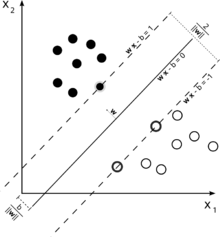What's xxx
An SVM model is a representation of the examples as points in space, mapped so that the examples of the separate categories are divided by a clear gap that is as wide as possible. New examples are then mapped into that same space and predicted to belong to a category based on which side of the gap they fall on.
In addition to performing linear classification, SVMs can efficiently perform a non-linear classification using what is called the kernel trick, implicitly mapping their inputs into high-dimensional feature spaces. The transformation may be nonlinear and the transformed space high dimensional; thus though the classifier is a hyperplane in the high-dimensional feature space, it may be nonlinear in the original input space.
Classifying data is a common task in machine learning. Suppose some given data points each belong to one of two classes, and the goal is to decide which class a new data point will be in. In the case of support vector machines, a data point is viewed as a p-dimensional vector (a list of p numbers), and we want to know whether we can separate such points with a (p − 1)-dimensional hyperplane. This is called a linear classifier. We choose the hyperplane so that the distance from it to the nearest data point on each side is maximized. If such a hyperplane exists, it is known as the maximum-margin hyperplane and the linear classifier it defines is known as a maximum margin classifier.
Any hyperplane can be written as the set of points $mathbf{x}$ satisfying
$mathbf{w}cdotmathbf{x} - b=0,\,$
where $cdot$ denotes the dot product and ${mathbf{w}}$ the (not necessarily normalized) normal vector to the hyperplane.

Maximum-margin hyperplane and margins for an SVM trained with samples from two classes. Samples on the margin are called the support vectors.
It was converted into a quadratic programming optimization problem. The solution can be expressed as a linear combination of the training vectors
$mathbf{w} = sum_{i=1}^n{alpha_i y_imathbf{x_i}}.$
Only a few $alpha_i$ will be greater than zero. The corresponding $mathbf{x_i}$ are exactly the support vectors, which lie on the margin and satisfy $y_i(mathbf{w}cdotmathbf{x_i} - b) = 1$. From this one can derive that the support vectors also satisfy
$mathbf{w}cdotmathbf{x_i} - b = 1 / y_i = y_i iff b = mathbf{w}cdotmathbf{x_i} - y_i$
which allows one to define the offset b. In practice, it is more robust to average over all $N_{SV}$ support vectors:
$b = frac{1}{N_{SV}} sum_{i=1}^{N_{SV}}{(mathbf{w}cdotmathbf{x_i} - y_i)}$
Writing the classification rule in its unconstrained dual form reveals that the maximum-margin hyperplane and therefore the classification task is only a function of the support vectors, the subset of the training data that lie on the margin.
Using the fact that $|mathbf{w}|^2 = mathbf{w}cdot mathbf{w}$ and substituting $mathbf{w} = sum_{i=1}^n{alpha_i y_imathbf{x_i}}$, one can show that the dual of the SVM reduces to the following optimization problem:
Maximize (in $alpha_i$ )
$ ilde{L}(mathbf{alpha})=sum_{i=1}^n alpha_i - frac{1}{2}sum_{i, j} alpha_i alpha_j y_i y_j mathbf{x}_i^T mathbf{x}_j=sum_{i=1}^n alpha_i - frac{1}{2}sum_{i, j} alpha_i alpha_j y_i y_j k(mathbf{x}_i, mathbf{x}_j)$
subject to (for any $i = 1, dots, n$)
$alpha_i geq 0,\, $
and to the constraint from the minimization in $b$
$sum_{i=1}^n alpha_i y_i = 0.$
Here the kernel is defined by $k(mathbf{x}_i,mathbf{x}_j)=mathbf{x}_icdotmathbf{x}_j.$
$W$ can be computed thanks to the $alpha$ terms:
$mathbf{w} = sum_i alpha_i y_i mathbf{x}_i.$